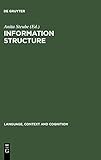Information Structure : Theoretical and Empirical Aspects / ed. by Anita Steube.
Material type: TextSeries: Language, Context and Cognition ; 1Publisher: Berlin ; Boston : De Gruyter, [2013]Copyright date: ©2004Edition: Reprint 2013Description: 1 online resource (360 p.) : Zahlr. AbbContent type:
TextSeries: Language, Context and Cognition ; 1Publisher: Berlin ; Boston : De Gruyter, [2013]Copyright date: ©2004Edition: Reprint 2013Description: 1 online resource (360 p.) : Zahlr. AbbContent type: - 9783110179347
- 9783110905892
- 400
- online - DeGruyter
- Issued also in print.
| Item type | Current library | Call number | URL | Status | Notes | Barcode | |
|---|---|---|---|---|---|---|---|
 eBook
eBook
|
Biblioteca "Angelicum" Pont. Univ. S.Tommaso d'Aquino Nuvola online | online - DeGruyter (Browse shelf(Opens below)) | Online access | Not for loan (Accesso limitato) | Accesso per gli utenti autorizzati / Access for authorized users | (dgr)9783110905892 |
Browsing Biblioteca "Angelicum" Pont. Univ. S.Tommaso d'Aquino shelves, Shelving location: Nuvola online Close shelf browser (Hides shelf browser)
Frontmatter -- Contents -- Introduction -- Degrees of Contrast and the Topic-Focus Articulation -- Information Structure and Modular Grammar -- Negative Descriptions of Events: Semantic and Conceptual Aspects of Sentence Negation and its Relevance for Information Structure -- Two Types of Contrastive Topics? -- Information Structure – Two-dimensionally Explicated -- Topic Constraints in the German Middlefield -- Contrastive Word Stress in Vedic Endo- and Exocentric Compounds -- Towards a Scalar Notion of Information Structural Markedness -- Prosody in Dialogues and Single Sentences: How Prosody can influence Speech Perception -- On the Independence of Information Structural Processing from Prosody -- The Prosodic Pattern of Contrastive Accent in Russian -- Focus Structure and the Processing of Word Order Variations in German -- International Patterns in Contrast and Concession -- Prosody in Contrast -- Short Portraits of the Authors -- Index
restricted access online access with authorization star
http://purl.org/coar/access_right/c_16ec
Der Band behandelt die Schnittstelle zwischen Pragmatik, Grammatik und Psycholinguistik bzw. Neurolinguistik. Pragmatisch bedingt sind die Zurechnungen von Satzteilen zur bekannten oder zur Neuinformation im Text. Realisiert werden die pragmatischen Gliederungen aber in der Grammatik. Die theoretische Modellierung erfolgte in generativen Grammatiken, in optimalitätstheoretischen Modellen oder anhand der Alternativsemantik.Der Schwerpunkt der Untersuchung liegt auf Korrekturkonstruktionen und auf Hutkonturen. Erstere zeichnen sich durch Kontrastakzente aus und Letztere sind zweigipflig akzentuiert. Um die Prosodie weiterzuentwickeln, beschäftigt sich die Hälfte der Beiträge mit dem psycholinguistischen und neurophysiologischen Nachweis der Intonationsparameter und mit ihrer Auswertung im Kontext.Von der Kontrastintonation geht der Band dann über zur Typologie von Kontrastkonstruktionen, zu ihrem grammatischen Vergleich und ihrer textuellen Verwendung.
The first volume of the series is devoted to the subjects "information structure" and "contrast". The working hypothesis is that, apart from the use of lexical indication, the expression of contrast vs. correction is primarily carried by the intonation contour as a means for indicating scope and focus in negating constructions. The papers in this volume proceed from the premise that the information structure is preformed conceptually, and on articulation in the dynamic context is then portioned and linearized, mapped onto the syntactic representation via the semantic representation, and finally realized intonationally. The findings are partly based on neurolinguistic and psycholinguistic experiments.
Issued also in print.
Mode of access: Internet via World Wide Web.
In English.
Description based on online resource; title from PDF title page (publisher's Web site, viewed 28. Feb 2023)









